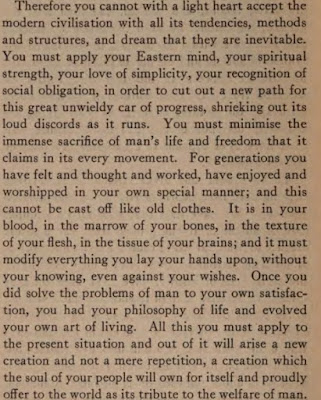The life and spirit of Calcutta are dominated by two towering figures:
Mother Teresa, firstly, and secondly, Rabindranath Tagore. The latter, of
course, was a native Bengali and his ancestral home, the great mansion of
Jorasanko, is located in the northern suburbs of the city. It was quite by
chance that the present author stumbled upon this location the other day and
spent several hours wandering through the meticulously compiled and beautifully
maintained museum there. He has always been somewhat ambivalent about Tagore,
since some of the polymath’s political views do not always quite coincide with
his own, and the literary merit of Tagore’s work is best appreciated in
Bengali, and nor is he very keen on Tagore’s paintings, but there is no
question that Tagore was a considerable figure in and beyond his historical
context – the Shakespeare of modern
India - and a visit to Jorasanko reveals many aspects of his character and work
that are not widely appreciated. Certainly, the author came away from the visit
with an enhanced view of the poet and his ouvre.
One unexpected aspect of Tagore deserves particular mention, namely his
connections with Japan. The present writer, at least, was wholly unaware of
these until he chanced upon a series of displays at Jorasanko which had been
sponsored by the Mitsubishi Corporation. These displays are lovingly assembled,
very professional and entirely worthwhile. We learn there that Tagore, the
internationalist, had an enduring fascination for Japan and Japanese culture and
cultivated several deep friendships with Japanese artists. Indeed, we learn
that he wrote some important essays on matters concerning Japan as part of his
general concern for a united and revitalized Asiatic civilization. This
revelation led the present author to download and read Tagore’s 1916 lecture,
The Message of India to Japan, a wonderful and illuminating work. Find the link
to it here.
Travelling in India and in Japan one becomes aware of their kinship.
Most obviously, there is the emblem of the swastika decorating both places, and
the heritage of Buddhism. What begins in India is finished, culminates and is refined
in Japan. The two countries are the start and finish of one great tide of human
civilization. That is how Tagore saw it, anyway. And he was impressed – as was
everyone – by the miraculous ability of the Japanese to modernize so rapidly
and thus show, most abruptly, that the “East” (as Tagore calls it) is not
retarded and backward, forever subservient to the conquering empires of the
“West”. In 1916 the Japanese had just demonstrated that it was possible for
Eastern civilization to leap into the modern era and claim its own modernity.
Yet this presented certain dangers, Tagore thought, and it is on both the
opportunities and the dangers of the revivification of the East that he dwells
in this erudite and beautifully articulate lecture. He is especially concerned –
with good reason - about the dangers of a belligerent nationalism in Japan and
an accompanying militarism.
Readers of these current pages are encouraged to download and read the
whole lecture for themselves. It is highly recommended. The issues of which it
treats are as relevant today as when it first appeared, and it serves as an
excellent introduction to an aspect of Tagore not often explored anymore. The
quality of his thought, and the elegance of his expression, is impressive.
It is worth remembering that he died in 1941 and did not live to see
the full tragedy of the Second World War.
Here are some representative excerpts from this insightful and
prescient speech by the great poet of Calcutta at the Imperial University in Tokyo:
Yours,
Harper McAlpine Black







No comments:
Post a Comment